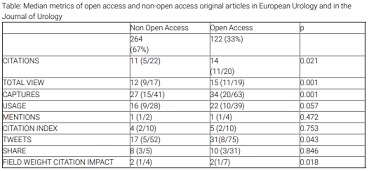Back
Poster, Podium & Video Sessions
Moderated Poster
MP19: Education Research II
MP19-09: Open Access Journals have higher metrics than non-open access journals: analysis of European Urology and Journal of urology Metrics
Saturday, May 14, 2022
7:00 AM – 8:15 AM
Location: Room 228
Riccardo Lombardo*, Antonio Cicione, Rome, Italy, Antonio Nacchia, Rionero in Vulture, Italy, Beatrice Turchi, Giacomo Gallo, Carmen Gravina, Alessandro Guercio, Jordi Stira, Lorenzo Maria Rovesti, Antonio Franco, Giorgio Guarnotta, Elisa Mancini, Olivia Alessandra Voglino, Valeria Baldassarri, Simone D'Annunzio, Sara Riolo, Andrea Tubaro, Cosimo De Nunzio, Rome, Italy
- RL
Poster Presenter(s)
Introduction: In the past few years, several journals have become open access in order to increase the impact of their publication. Aim of our study is to assess the impact of open access articles versus non-open access articles in the European Urology journal and in the Journal of Urology.
Methods: All the original articles published in 2019 in European Urology and Journal of Urology were reviewed. Scopus database was used to evaluate citations, total views, captures, usage, mentions, tweets, share, likes, comments and field weighted citation impact. Metrics of open access articles were compared to non- open access articles. Mann Whitney test was used to evaluate statistically significant differences.
Results: Overall 386 articles were evaluated, 141 were published in European urology and 245 in the Journal of Urology. Overall 122 (33%) were open access. Open access articles presented a higher median citation index (14 vs 11, p<0,05), higher median total views (15 vs 12, p<0,05), higher captures (34 vs 27, p<0,05, higher median tweets (31 vs 17, p<0,05) when compared to non-open access journals. No differences in terms of mentions, citation index and shares were recorded.
Conclusions: The present analysis suggest that open access articles have higher metrics than non-open access articles. Authors should keep in mind our data when choosing publishing options.
Source of Funding: None

Methods: All the original articles published in 2019 in European Urology and Journal of Urology were reviewed. Scopus database was used to evaluate citations, total views, captures, usage, mentions, tweets, share, likes, comments and field weighted citation impact. Metrics of open access articles were compared to non- open access articles. Mann Whitney test was used to evaluate statistically significant differences.
Results: Overall 386 articles were evaluated, 141 were published in European urology and 245 in the Journal of Urology. Overall 122 (33%) were open access. Open access articles presented a higher median citation index (14 vs 11, p<0,05), higher median total views (15 vs 12, p<0,05), higher captures (34 vs 27, p<0,05, higher median tweets (31 vs 17, p<0,05) when compared to non-open access journals. No differences in terms of mentions, citation index and shares were recorded.
Conclusions: The present analysis suggest that open access articles have higher metrics than non-open access articles. Authors should keep in mind our data when choosing publishing options.
Source of Funding: None


.jpg)
.jpg)